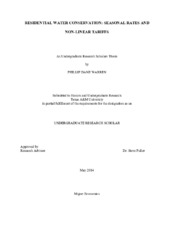| dc.creator | Warren, Phillip Dane | |
| dc.date.accessioned | 2016-09-05T14:28:26Z | |
| dc.date.available | 2016-09-05T14:28:26Z | |
| dc.date.created | 2014-05 | |
| dc.date.issued | 2013-09-19 | |
| dc.date.submitted | May 2014 | |
| dc.identifier.uri | https://hdl.handle.net/1969.1/157567 | |
| dc.description.abstract | With drought conditions and climate change creating an increasingly pressing issue, water conservation has become profoundly important. This work quantifies the effectiveness of residential water conservation programs, namely non-linear tariff functions and seasonal rates, at inducing household water customers to conserve water.
The analysis of non-linear tariffs and seasonal rates commences through a clustering study, measuring consumption at certain kink points in pricing. If customers respond to prices by reducing consumption, then one should observe a bunching of customers who consume just below kink points where the marginal price of water increases. I use detailed customer-level data on monthly water consumption from a water utility in Texas to test for the behavioral response to discrete increases in the marginal price of water. This work concludes that consumers in this region do not respond to price changes at the kink points in non-linear tariff functions in a statistically significant way. | en |
| dc.format.mimetype | application/pdf | |
| dc.subject | Water Conservation
Economics | en |
| dc.title | Residential Water Conservation: Seasonal Rates and Non-Linear Tariffs | en |
| dc.type | Thesis | en |
| thesis.degree.department | Economics | en |
| thesis.degree.discipline | Economics | en |
| thesis.degree.grantor | Undergraduate Research Scholars Program | en |
| dc.contributor.committeeMember | Puller, Steve | |
| dc.type.material | text | en |
| dc.date.updated | 2016-09-05T14:28:26Z | |


